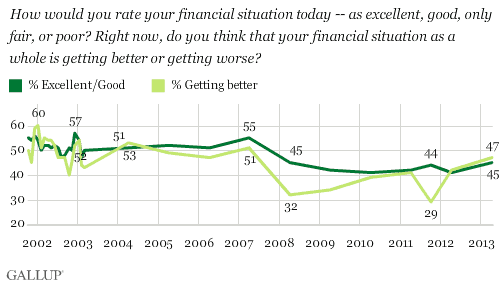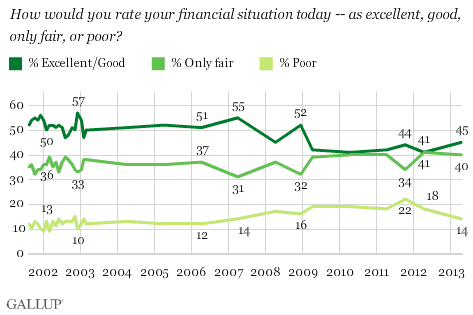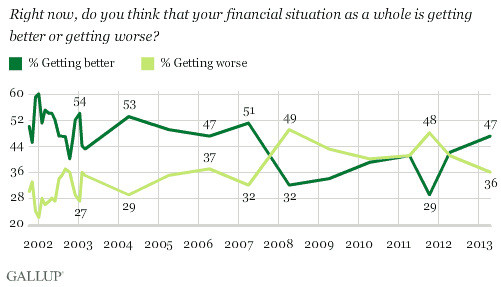PRINCETON, NJ -- Forty-five percent of Americans rate their personal financial situation as excellent or good, and 47% say their financial situation is getting better. These ratings are improved from previous points over the last several years, but have not yet returned to the levels found prior to the 2008 financial crisis.

These data are from Gallup's Economy and Personal Finance survey, conducted annually since 2001. This year's survey includes 2,017 interviews, conducted April 4-14.
BIG TRENDS: Read more in our on going series The New American Consumer
Americans Still Divided on Their Personal Financial Situation
While 45% of Americans say their personal financial situation is excellent or good, another 40% say it is "only fair" and 14% see it as "poor."
At various points between 2001 and 2007, more than half of Americans rated their personal financial situations as excellent or good. That changed in 2008, although not dramatically, when it slipped to 45%. Americans' views improved in December 2008, just after the election of Barack Obama as president, but then bottomed out in April 2010 and in April 2012, when 41% put themselves in the top two categories. The current situation in which 45% of Americans rate their finances as excellent or good, although improved, remains below any measurement point prior to 2008.

Financial Optimism, Though Historically Volatile, Now Most Positive Since April 2007
The 47% of Americans who say their financial situation is getting better is the highest reading since April 2007. But Americans' optimism about the direction of their finances has been generally more volatile over the last 12 years than their ratings of their current financial situation.
In 2001, when Gallup began measuring Americans' financial optimism, 50% said their situation was getting better and 30% said it was getting worse. The high point for optimism came in January 2002, when 60% said their finances were getting better.
Optimism plunged between 2007 and 2008 as the financial crisis set in. Ratings have seesawed since then, including the all-time low of 29% "getting better" in October 2011.

Implications
Americans are becoming somewhat more sanguine about their personal financial situations, but have not yet returned to the positivity exhibited prior to the beginning of the 2008 financial crisis. This fits with other Gallup economic measures, including economic confidence and mentions of the economy as the nation's most important problem, which have shown improvement, but have not yet returned to the "good old days of yesteryear," prior to 2008.
Gallup will explore key demographic, socioeconomic, and political differences in views of personal finances in Part II of this series next week.
Survey Methods
Results for this Gallup poll are based on telephone interviews conducted April 4-7 and April 11-14, 2013, with a random sample of 2,017 adults, aged 18 and older, living in all 50 U.S. states and the District of Columbia.
For results based on the total sample of national adults, one can say with 95% confidence that the margin of sampling error is ±3 percentage points.
Interviews are conducted with respondents on landline telephones and cellular phones, with interviews conducted in Spanish for respondents who are primarily Spanish-speaking. Each sample of national adults includes a minimum quota of 50% cellphone respondents and 50% landline respondents, with additional minimum quotas by region. Landline telephone numbers are chosen at random among listed telephone numbers. Cellphone numbers are selected using random digit dial methods. Landline respondents are chosen at random within each household on the basis of which member had the most recent birthday.
Samples are weighted to correct for unequal selection probability, nonresponse, and double coverage of landline and cell users in the two sampling frames. They are also weighted to match the national demographics of gender, age, race, Hispanic ethnicity, education, region, population density, and phone status (cellphone only/landline only/both, cellphone mostly, and having an unlisted landline number). Demographic weighting targets are based on the March 2012 Current Population Survey figures for the aged 18 and older U.S. population. Phone status targets are based on the July-December 2011 National Health Interview Survey. Population density targets are based on the 2010 census. All reported margins of sampling error include the computed design effects for weighting.
In addition to sampling error, question wording and practical difficulties in conducting surveys can introduce error or bias into the findings of public opinion polls.
View methodology, full question results, and trend data.
For more details on Gallup's polling methodology, visit www.gallup.com.
